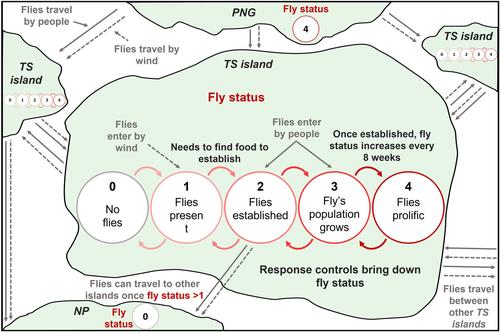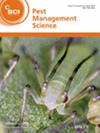Dynamic spatial network simulation accounting for multiple ecological factors provides practical recommendations for biosecurity early detection and rapid response (EDRR) strategies
Eleanor May Cervigni, Rodrigo Pires, Elizabeth Joan Trevenen, David Britton, Barbara Waterhouse, Jane Evelyn Royer, Michael Renton
求助PDF
{"title":"Dynamic spatial network simulation accounting for multiple ecological factors provides practical recommendations for biosecurity early detection and rapid response (EDRR) strategies","authors":"Eleanor May Cervigni, Rodrigo Pires, Elizabeth Joan Trevenen, David Britton, Barbara Waterhouse, Jane Evelyn Royer, Michael Renton","doi":"10.1002/ps.8507","DOIUrl":null,"url":null,"abstract":"BACKGROUNDGlobally the spread of invasive pests is being facilitated by increased human mobility and climate change. Simulation modelling can help assess biosecurity strategies for early detection and rapid response (EDRR), but has struggled to account for important factors in the invasion process, such as spatial and temporal variability in habitat suitability and connectivity; population dynamics; and multiple dispersal pathways.We developed a novel dynamic spatial network simulation approach based on spatial network theory that enables integration of a wider range of spatio‐temporal factors than previous studies, calibrated it against extensive historical trapping data, and applied it to comprehensively analyse the EDRR strategy for Oriental fruit fly (<jats:italic>Bactrocera dorsalis</jats:italic>; OFF) in northern Australia.RESULTSSimulations indicated that the chance of OFF reaching the mainland in the next 20 years could be up to 20% under the current EDRR strategy, depending on how optimistic or pessimistic model assumptions are, and highlighted possible improvements to the EDRR strategy for further consideration. Simulations under optimistic assumptions indicate that transport via wind is most important in OFF reaching the mainland, but under pessimistic assumptions transport via people carrying infected fruit becomes more important.CONCLUSIONOur new dynamic spatial network simulation approach can account for a wide range of spatio‐temporal ecological factors to provide practical real‐world recommendations. At a minimum, this approach only requires weather and population data, both of which are available globally from a variety of free and open sources, making it broadly applicable to assessing the EDRR strategies in place for different species in other locations. © 2024 Society of Chemical Industry.","PeriodicalId":218,"journal":{"name":"Pest Management Science","volume":"1 1","pages":""},"PeriodicalIF":3.8000,"publicationDate":"2024-11-08","publicationTypes":"Journal Article","fieldsOfStudy":null,"isOpenAccess":false,"openAccessPdf":"","citationCount":"0","resultStr":null,"platform":"Semanticscholar","paperid":null,"PeriodicalName":"Pest Management Science","FirstCategoryId":"97","ListUrlMain":"https://doi.org/10.1002/ps.8507","RegionNum":1,"RegionCategory":"农林科学","ArticlePicture":[],"TitleCN":null,"AbstractTextCN":null,"PMCID":null,"EPubDate":"","PubModel":"","JCR":"Q1","JCRName":"AGRONOMY","Score":null,"Total":0}
引用次数: 0
引用
批量引用
Abstract
BACKGROUNDGlobally the spread of invasive pests is being facilitated by increased human mobility and climate change. Simulation modelling can help assess biosecurity strategies for early detection and rapid response (EDRR), but has struggled to account for important factors in the invasion process, such as spatial and temporal variability in habitat suitability and connectivity; population dynamics; and multiple dispersal pathways.We developed a novel dynamic spatial network simulation approach based on spatial network theory that enables integration of a wider range of spatio‐temporal factors than previous studies, calibrated it against extensive historical trapping data, and applied it to comprehensively analyse the EDRR strategy for Oriental fruit fly (
Bactrocera dorsalis ; OFF) in northern Australia.RESULTSSimulations indicated that the chance of OFF reaching the mainland in the next 20 years could be up to 20% under the current EDRR strategy, depending on how optimistic or pessimistic model assumptions are, and highlighted possible improvements to the EDRR strategy for further consideration. Simulations under optimistic assumptions indicate that transport via wind is most important in OFF reaching the mainland, but under pessimistic assumptions transport via people carrying infected fruit becomes more important.CONCLUSIONOur new dynamic spatial network simulation approach can account for a wide range of spatio‐temporal ecological factors to provide practical real‐world recommendations. At a minimum, this approach only requires weather and population data, both of which are available globally from a variety of free and open sources, making it broadly applicable to assessing the EDRR strategies in place for different species in other locations. © 2024 Society of Chemical Industry.
考虑多种生态因素的动态空间网络模拟为生物安全早期检测和快速反应 (EDRR) 战略提供了实用建议
背景由于人类流动性的增加和气候变化,入侵害虫在全球范围内蔓延。模拟建模有助于评估早期检测和快速反应(EDRR)的生物安全策略,但却难以考虑入侵过程中的重要因素,如栖息地适宜性和连通性的时空变异性、种群动态和多种扩散途径。我们在空间网络理论的基础上开发了一种新的动态空间网络模拟方法,与以前的研究相比,这种方法能整合更多的时空因素,并根据大量的历史诱捕数据对其进行了校准,然后将其用于全面分析澳大利亚北部东方果蝇(Bactrocera dorsalis; OFF)的EDRR战略。结果模拟结果表明,在当前的 EDRR 战略下,未来 20 年内 OFF 到达大陆的几率最高可达 20%,这取决于模型假设的乐观或悲观程度,并强调了对 EDRR 战略的可能改进,以供进一步考虑。乐观假设下的模拟结果表明,通过风的传播对 OFF 到达大陆最为重要,但在悲观假设下,通过携带受感染水果的人的传播变得更加重要。这种方法至少只需要天气和人口数据,而这两种数据在全球范围内都可以从各种免费和开放的来源获得,因此它广泛适用于评估其他地方针对不同物种实施的 EDRR 战略。© 2024 化学工业协会。
本文章由计算机程序翻译,如有差异,请以英文原文为准。



